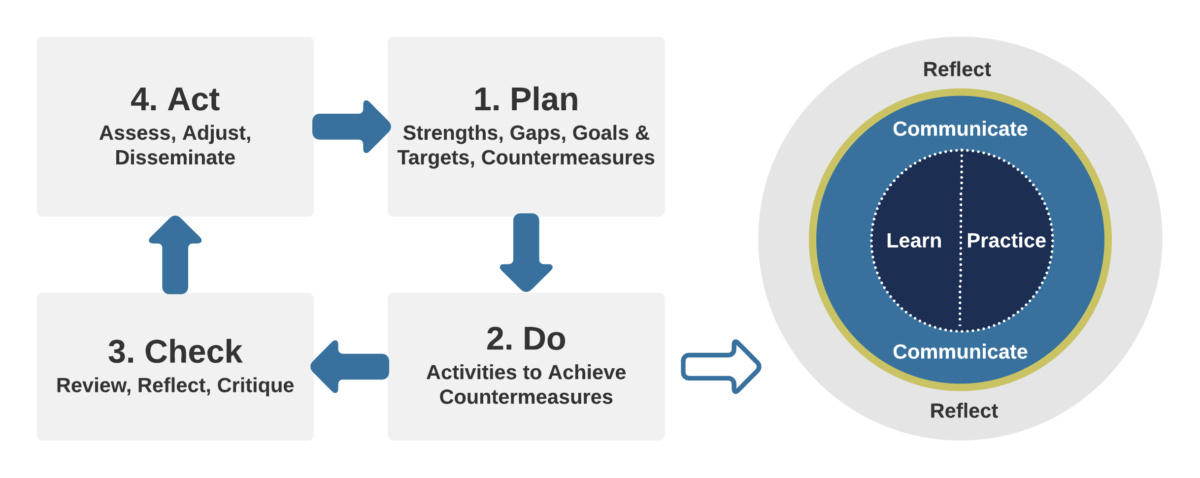What makes LCS CPD different?
The unique LCS PDCA CPD Cycle - pictured below - is inherently lean – providing you with a framework to:
- Develop a CPD A3 Plan with Strengths, Gaps, Goals and Activities
- Do your planned CPD activities and log them
- Check and Reflect on each CPD activity as you complete it
- Check and Act to assess and adjust the plan, during the cycle, and at the end of it in preparation for the next Plan
Other differentiators and key features include:
- Your plan can be multi faceted, enabling you to address skill or ability improvements that you need to make in any or all of the ‘Doing’ Activities of Practice, Communications and Learning
- It uses evidence-based progress assessments that you set yourself
- There are no arbitrary targets decided by LCS or any other body
- It’s self directed and self managed, though LCS approves and endorses your plans and your progress
The LCS CPD Cycle

The Plan phase starts the cycle and states key goals. The Do part of the cycle is the core ongoing element, comprising of three types of activities: practicing, learning and communicating. Check allows you to assess your progress, while Act is about adjusting your plan for the next cycle.
Your cycle should be completed within twelve months of starting your Premium Practitioner Membership (PPM). If you complete your cycle in, say, nine months you simply start another cycle by creating a new A3 plan. Note that you must have a valid PPM in order to create a new CPD cycle
CPD Cycle Detail
1) The CPD A3 Plan
The A3 plan provides the framework for your ongoing practicing, learning and communicating activities and is a statement of intent regarding your professional development.
For each of the practicing, learning and communicating areas in your plan, you state your:
- Vision
- Strengths and Gaps
- Goals and Targets
- Countermeasures to close Gaps
2) The ‘Doing’ Activities
Practicing and learning are the leading doing activities. Practicing includes projects, programmes and activities undertaken as part of a CI role.
Learning is achieved through education, training and conferences etc. Communication activities include teaching, sharing, writing, coaching and mentoring.
Note that reflecting on all your activities should be continuous and when you reflect on an CPD activity, answer these questions:
- What did I learn from it?
- How will I use this learning?
- What further action will I take?
A list of 'doing' activities:
Practicing
Practicing is about using your skills in the workplace, applying knowledge learned and engaging in an activity for the purpose of improvement, solving problems, etc.
- Undertaking specific CI projects
- Participating in improvement events
- Fulfilling the requirements a lean/CI focused job or role
Learning
Learning is about acquiring lean oriented knowledge or skills through formal education, training, research, study and on the job experience.
- Participating in formal training courses
- Undertaking formal further or high education
- Attending conferences, seminars, workshops
- Reading
- Researching
- Observation
Communicating
Communicating is about sharing opinions, exchanging or imparting knowledge among colleagues, networks, communities or organisations.
Communicating is sub divided into SHARING KNOWLEDGE and TEACHING & GUIDING
SHARING KNOWLEDGE
- Writing articles, blogs etc
- Making presentations, delivering briefings
TEACHING & GUIDING
- Facilitating
- Coaching
- Instructing
- Mentoring
- Lecturing
3) Checking, Reflecting & Assessing Progress
Reflecting is about contemplating your learning and experiences and essentially asking the question, “what did I get out of this?” and "how have I progressed?" It requires critical thinking and critical reflection.
At these stages you formally assess your progress towards your goals, based on the activities you have undertaken.
Remember, reflection is an ongoing process.
4) Acting
Acting involves adjusting your plan following your assessing, checking and reflecting stage. Your plan may need to change because new unforeseen opportunities have arisen, or priorities changed, or you may have achieved your goals and need to start a new CPD cycle and create a new A3 plan.
Your First CPD Cycle Overview
- You upgrade to Premium Practitioner Membership.
- CPD is now available in your LCS membership Account menu.
- You access your A3 Plan template and create your first plan.
- The LCS reviews and approves the A3 plan.
- You start the CPD cycle by recording activities on your Activity Log as they take place.
- You undertake periodic checks on progress using the Progress Check Record
- The LCS endorses your progress checks and finally endorses your cycle when is considered complete.
- Your completed plan is archived and you create a new A3 plan for the next CPD cycle.


